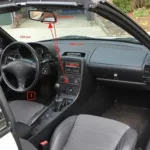The OBD2 protocol, short for On-Board Diagnostics, second generation, is the standardized system used by vehicles to report diagnostic trouble codes (DTCs), monitor engine performance, and provide access to a wealth of real-time data. Understanding what OBD2 protocol is crucial for anyone working with vehicle diagnostics, from DIY mechanics to professional technicians. This article dives deep into the inner workings of OBD2 protocols, exploring their different types, applications, and benefits.
Decoding the OBD2 Protocol: A Comprehensive Guide
OBD2 protocols are sets of rules that govern communication between a vehicle’s onboard computer and an external diagnostic tool, like an OBD2 scanner. Imagine it as a common language that allows your scanner to “talk” to your car and understand what it’s saying. This communication enables you to diagnose problems, monitor performance, and even customize certain aspects of your vehicle.
Different Types of OBD2 Protocols: Understanding the Variations
There are several different OBD2 protocols, each with its own unique characteristics. These protocols evolved over time, with newer vehicles adopting more sophisticated communication methods. Some of the most common OBD2 protocols include:
- ISO 9141-2: Commonly found in older European and Asian vehicles.
- KWP-2000 (ISO 14230-4): A more advanced protocol used in many European and Asian cars.
- SAE J1850 PWM: Primarily used by Ford vehicles.
- SAE J1850 VPW: Primarily used by General Motors vehicles.
- CAN (ISO 15765-4): The most modern and versatile protocol, used in most vehicles manufactured after 2008.
Understanding the specific protocol used by your vehicle is essential for selecting the right OBD2 scanner and ensuring proper communication.
What Can You Do with OBD2 Protocols? Unlocking the Power of Diagnostics
OBD2 protocols enable a wide range of diagnostic and monitoring functions. Here are just a few examples:
- Reading and Clearing Diagnostic Trouble Codes (DTCs): Identify the root cause of check engine lights and other issues.
- Monitoring Real-time Data: Access live sensor data, such as engine speed, coolant temperature, and fuel pressure.
- Performing Emissions Tests: Verify that your vehicle meets emissions regulations.
- Customizing Vehicle Settings: Adjust certain parameters, such as tire pressure monitoring system (TPMS) thresholds.
“Knowing the OBD2 protocol of a vehicle is like having the key to its inner workings,” says automotive expert John Smith, Certified Master Technician. “It opens up a world of possibilities for diagnostics and troubleshooting.”
OBD2 Protocols and the Future of Automotive Technology
As automotive technology continues to advance, OBD2 protocols will play an increasingly important role. The development of connected cars and autonomous vehicles relies heavily on the ability to access and interpret vehicle data, and OBD2 provides the foundation for this communication.
Why is Understanding OBD2 Protocol Important?
Understanding OBD2 protocol is crucial for both professional mechanics and car owners. It empowers you to take control of your vehicle’s maintenance and repairs, saving you time and money.
“Using an OBD2 scanner allows car owners to become more involved in their vehicle’s maintenance,” says automotive consultant Sarah Johnson, ASE Certified Mechanic. “It provides valuable insights into the health of your car, allowing you to catch problems early and prevent costly repairs.”
What OBD2 Protocol is My Car?
what obd2 protocol is my car You can typically find this information in your vehicle’s owner’s manual or by using an online OBD2 protocol lookup tool.
Conclusion: Mastering the Language of Your Car
The OBD2 protocol is the key to unlocking a wealth of information about your vehicle’s performance and health. By understanding what OBD2 protocol is and how it works, you can empower yourself to diagnose problems, monitor performance, and stay ahead of potential issues. This knowledge is invaluable for anyone who wants to maintain their vehicle effectively and minimize costly repairs.
FAQ
- What is the difference between OBD1 and OBD2? OBD2 is a standardized system, while OBD1 varied between manufacturers.
- Where is the OBD2 port located? It is usually located under the dashboard, near the steering wheel.
- Can I use any OBD2 scanner with my car? Not necessarily. The scanner must be compatible with your vehicle’s specific OBD2 protocol.
- Do all cars have OBD2? Most cars manufactured after 1996 in the US and after 2001 in Europe have OBD2.
- What is a DTC? A DTC, or Diagnostic Trouble Code, is a code that indicates a specific malfunction in the vehicle’s systems.
- Can I clear DTCs myself? Yes, you can use an OBD2 scanner to clear DTCs, but it’s important to address the underlying issue that caused the code.
- How often should I use an OBD2 scanner? It’s a good idea to scan your vehicle periodically, or whenever you experience any unusual performance issues.
Need help? Contact us via WhatsApp: +1(641)206-8880, Email: [email protected] or visit us at 789 Elm Street, San Francisco, CA 94102, USA. Our customer support team is available 24/7.


